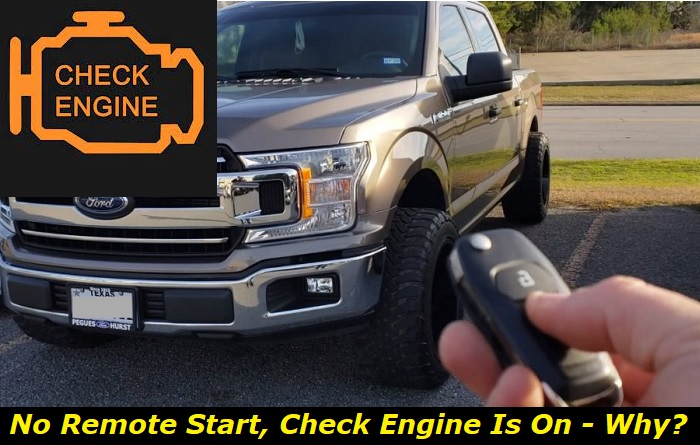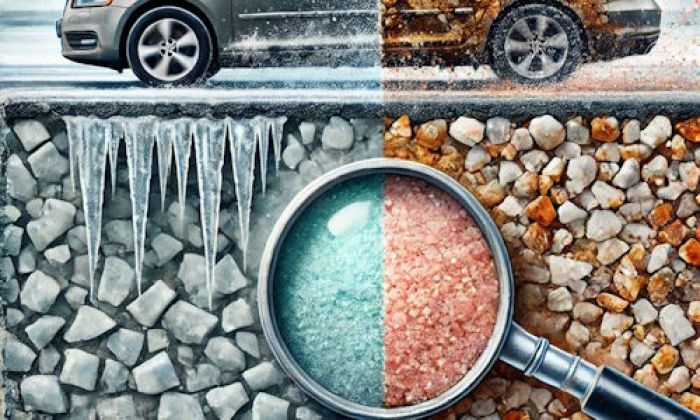Remote Start is a great feature in any vehicle that will let you start its engine without putting the key on the ignition or pushing a button. This way, you can get the air conditioning running to regulate the temperature in your car before you even enter it. In addition, this is a neat way to warm up your engine to operating temperatures during the winter.
Check engine light highlights
- Common reasons:vast choice of different problems
- How to fix:read the codes to narrow down the issue
- Possible consequences:depends on the actual culprit
- Priority level:Medium
- Can you drive?Carefully
- DIY repair:Impossible
- Repair price range:$150-$1,000

Don't fret because, in this article, we will show you what may be wrong so you can get this warning light and symptoms in your car running again without a hitch. Based on reports and stories shared by people who went through this ordeal, here are the most common causes of this problem and their possible solutions:
1. Loose Gas Cap
One of the most common factors preventing the Remote Start is a loose gas cap. A loose gas cap can cause the Remote Start to fail because it prevents the engine from getting the proper amount of fuel due to the presence of too much air mixture in the reservoir.
The same can also cause fuel to evaporate if left for a long time, which can affect the combustion of the engine. Likewise, dirt entering the gap can contaminate the fuel and bog the engine. These are the possible reasons why the Check Engine Light is turned on during this instance, too.
If you think you might have a loose gas cap, simply try to tighten it. When the gas cap no longer fits properly, it may need to be replaced.
2. Low on Oil
If your car is equipped with a remote starter, you may have experienced the frustration of trying to use it only to find that the engine doesn't start. In some cases, the Check Engine Light may even come on. Low oil can be the cause of these problems.
When there isn't enough oil in the reservoir, the engine can't be properly lubricated. This can lead to a number of issues, including preventing the engine from starting when activated via Remote Start. Additionally, low oil can trigger the Check Engine Light.
There are a few other symptoms that can indicate that your car's oil level is low. These include the engine making strange noises, excessive smoke coming from the exhaust, and the engine running rough.
If you notice any of these symptoms, it's important to check the oil level as soon as possible. If it is low, you'll need to add more oil. You can do this yourself or by taking the car to a mechanic.
Preventing low oil levels is the best way to avoid these problems. Be sure to regularly check the oil level and top it up as needed.
3. Dirty Engine Oil
Dirty oil can prevent the Remote Start from starting the engine and trigger the Check Engine Light for a few reasons. The most common reason is that dirty oil can cause the engine to overheat. When the engine overheats, it will automatically shut down to prevent further damage. This can happen even if the vehicle is not being driven and is just sitting in the garage.
Another possible symptom of this problem is that the engine may run rough or stall when first started. This is because dirty oil can cause deposits to build up on critical engine components. When these deposits build up, they can restrict airflow and fuel delivery to the engine, which can cause it to run poorly.
The cause of this problem is typically due to an oil change being overdue. When oil changes are neglected, the oil breaks down and becomes contaminated with dirt, dust, and other debris. This can cause the oil to become thick and sludgy, which can clog filters and restrict flow.
The best way to prevent this problem is to keep up with regular oil changes. Most vehicles should have their oil changed every 5,000 miles or so. However, it's always best to consult your owner's manual to see what the manufacturer recommends for your specific vehicle.
4. Worn Fuel and Oil Filter
If the Check Engine Light is on, it's possible that the fuel or oil filter is clogged. This can prevent the car from starting, regardless if you're using the Remote Start feature or the standard way to start it using the ignition switch.
The fuel filter traps impurities in the fuel, and over time it can become clogged. This can prevent the engine from getting enough fuel, and as a result, the car won't start if the power unit does not fire up. The oil filter does a similar job for oil. If it becomes clogged, it can prevent the engine from getting enough oil. This can also lead to engine lubrication problems, and eventually, the car won't crank its engine.
To fix this problem, you'll need to replace the fuel and oil filters. This is a relatively simple process, and you can find instructions in your car's owner's manual. You can also have it done by a mechanic for your convenience. Once the filters are replaced, the Check Engine Light should turn off and the car should start normally using your key fob.
5. Ignition System Issues
If your car's remote start system is failing to start the engine while activating the Check Engine Light, it could be due to an ignition system issue. One more possible symptom of this problem is the engine getting prone to stalling or running roughly from time to time.
There are a few different things that can cause this problem, but the most common is a faulty ignition coil. This can cause difficulty starting the engine and may also trigger the Check Engine Light. Other possible causes are a weak or damaged battery or faulty spark plugs.
The best way to solve this problem is to take your car to a mechanic or dealership and have them diagnose the part in the ignition system causing the issue and have it repaired or replaced depending on its condition.
6. Overheating
If your car's engine just began overheating, it can prevent the Remote Start from restarting the engine. The Check Engine Light may also come on at this stage.
There are other possible symptoms of an overheating engine, such as steam coming from under the hood, or the car's temperature gauge rising into the red zone. If you notice any of these symptoms, it's important to pull over and turn off the engine as soon as possible.
There are a few different things that can cause an engine to overheat. The primary reason is a low coolant level. This can happen if there's a leak in the cooling system, or if the coolant has run out. Another possibility is a problem with the water pump, which circulates the coolant through the engine. One more possibility is a faulty thermostat, which regulates the engine's temperature.
If your car's engine is overheating, there are a few things you can do to try to fix the problem. One is to add more coolant to the system. You can also try bleeding the cooling system, which will remove any air bubbles that might be causing the problem. If those things don't work, you may need to take your car to a mechanic to have it checked out and for possible parts repair or replacement.
Overheating can prevent the Remote Start from starting the engine and trigger the Check Engine Light. It's important to keep an eye on the temperature gauge and pull over if it starts to get too hot. You can try adding more coolant or bleeding the system yourself, but if those things don't work, you'll need to take your car to a mechanic.
7. ECU Errors
If you see the Check Engine Light come on in your car, it means that the On-Board Diagnostics (OBD) system has detected a problem. The OBD system monitors the engine and other systems in the vehicle to make sure they are working properly. If the system detects a problem, it will trigger the Check Engine Light.
In some cases, the Check Engine Light may also prevent the Remote Start from starting the engine as a precautionary measure. If the OBD system is not working properly, it may not allow the engine to be started remotely.
There are a few different reasons why the Check Engine Light may come on and prevent the Remote Start from working. One possibility is that there is a problem with the ECU itself. The ECU is the computer that controls the engine and other systems in the vehicle. If it is not working properly, it can cause the Check Engine Light to come on and prevent the Remote Start from working plus a plethora of other electrical issues.
Another possibility is that there is a problem with one of the sensors that the ECU uses to monitor the engine. These sensors are located throughout the engine and help the ECU to keep track of how well it is running. If one of these sensors is not working properly, it can cause the same issue.
Finally, there may be a problem with the wiring between the ECU and the sensors. If this wiring is damaged or not working properly, it can also result in the same problem.
If you are having trouble with your Remote Start not working, and you see the Check Engine Light come on, it is important to have the problem diagnosed as soon as possible. A qualified mechanic or dealership service department can hook up a diagnostic tool to the OBD system and read any codes that are stored in the system. This will help to identify what is causing the problem so that it can be fixed.
In some cases, the problem may be something as simple as a loose wire, faulty sensor, or a blown fuse, which definitely needs to be changed. However, if the problem is with the ECU itself, it will need to be reflashed if its software is only glitching or replaced if its hardware is damaged. The latter is a more expensive repair, but it is necessary in order to get the Remote Start working again.
Conclusion
Be sure to try all these possible solutions if you are having problems using the Remote Start feature of your vehicle while having a Check Engine Light warning on the dash. As seen here, these can be due to a lot of things but can be easy to diagnose and fix if the cause of the issue is caught early on.
About the authors
The CarAraC research team is composed of seasoned auto mechanics and automotive industry professionals, including individuals with advanced degrees and certifications in their field. Our team members boast prestigious credentials, reflecting their extensive knowledge and skills. These qualifications include: IMI: Institute of the Motor Industry, ASE-Certified Master Automobile Technicians; Coventry University, Graduate of MA in Automotive Journalism; Politecnico di Torino, Italy, MS Automotive Engineering; Ss. Cyril and Methodius University in Skopje, Mechanical University in Skopje; TOC Automotive College; DHA Suffa University, Department of Mechanical Engineering






Add comment